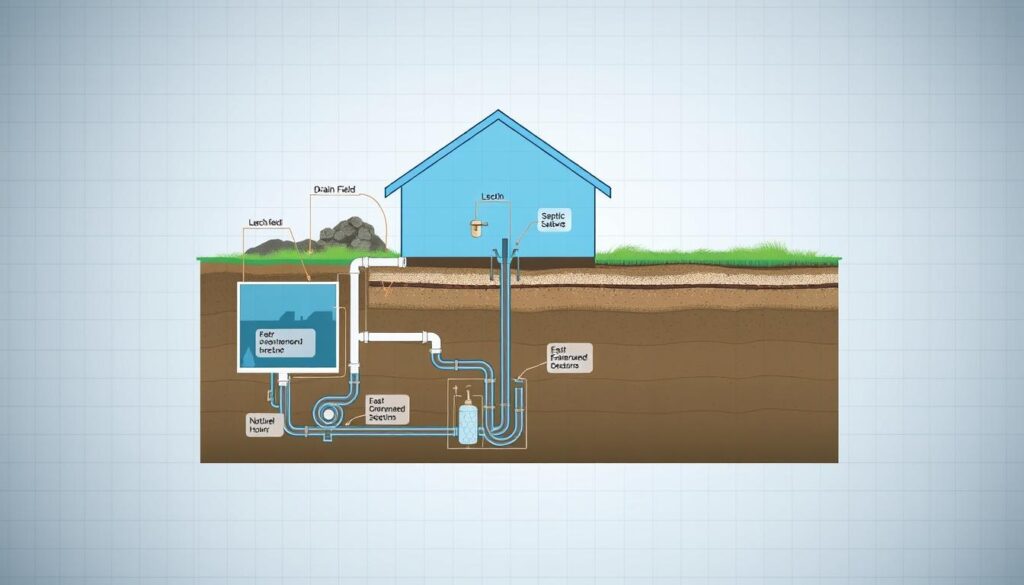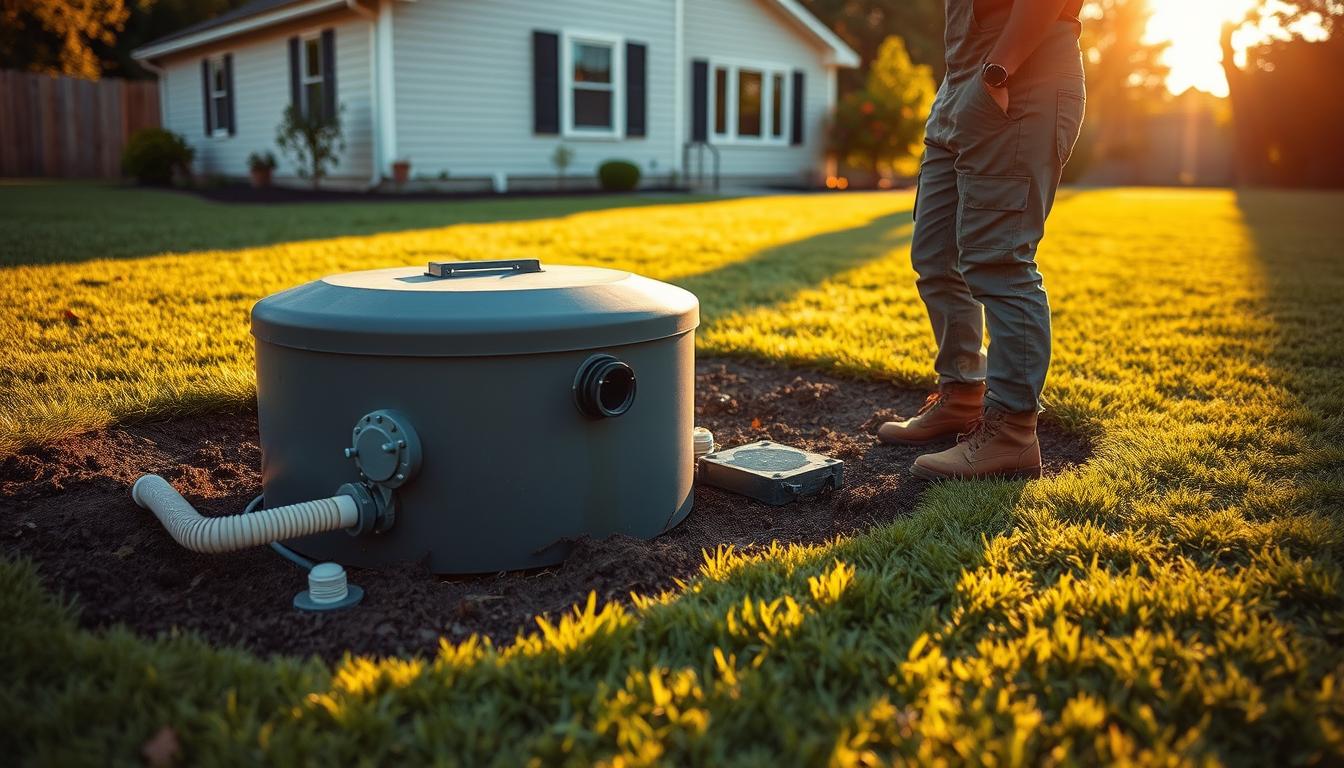Are you considering purchasing a home in a rural area? If so, you may be dealing with a septic system instead of a traditional sewer connection. Understanding how a septic system works is crucial to avoiding costly surprises down the line.
When you’re in the market for a new home, especially in rural areas, there’s a crucial aspect that often goes overlooked: the septic system. Failing to ask the right questions can lead to unexpected expenses and headaches. So, what should you be asking about the septic tank?
Key Takeaways
- Understand the basics of septic systems
- Know the importance of inspecting the septic tank
- Be aware of maintenance requirements
- Consider the age and condition of the septic system
- Factor in potential costs associated with septic tank maintenance
What You Need to Know About Septic Systems
Understanding septic systems is crucial for homeowners who rely on these systems for wastewater management. A septic system is a vital component of a home’s infrastructure, particularly for those living in areas not connected to municipal sewer lines.
How Septic Systems Function
A septic system functions by collecting wastewater from a home and treating it underground. The process begins with a pipe that collects all the home’s wastewater and transfers it to a watertight septic tank.
Components of a Typical Septic System
A typical septic system consists of two main components: the septic tank and the drain field. The septic tank is where wastewater is held and separated into three layers: scum, effluent, and sludge.
The Waste Treatment Process
The waste treatment process involves the breakdown of organic matter by bacteria within the septic tank. The effluent, or the middle layer, is then released into the drain field, where it is further filtered and treated by the soil.
Septic Systems vs. Municipal Sewer Connections
When comparing septic systems to municipal sewer connections, there are key differences in cost and maintenance responsibilities.
Cost Differences
| System Type | Initial Cost | Ongoing Costs |
|---|---|---|
| Septic System | $10,000 – $20,000 | $200 – $500 per year |
| Municipal Sewer | Connection fees: $500 – $2,000 | $50 – $200 per month |
Maintenance Responsibilities
Homeowners with septic systems are responsible for regular maintenance, including inspections and pumping. In contrast, municipal sewer users rely on the local water authority for maintenance.
Pros and Cons of Buying a Home With a Septic Tank
When considering purchasing a home with a septic tank, it’s crucial to understand both the benefits and drawbacks of such systems. Septic tanks are a viable alternative to municipal sewer connections, offering unique advantages and disadvantages that prospective homeowners should carefully evaluate.
Advantages of Septic Systems
One of the primary benefits of septic systems is their potential to reduce monthly utility costs. Since septic systems operate independently of municipal sewage, homeowners can avoid certain fees associated with public sewer systems.
Lower Monthly Utility Costs
Homeowners with septic systems can enjoy lower monthly expenses as they are not required to pay for municipal sewage services. This can lead to significant savings over time.
Environmental Benefits
Septic systems can also offer environmental benefits by treating wastewater on-site, reducing the demand on municipal treatment plants and potentially minimizing the risk of sewage overflows.
Disadvantages to Consider
Despite the advantages, there are significant drawbacks to consider when evaluating a home with a septic tank. Regular maintenance is crucial to ensure the system operates effectively.
Maintenance Requirements
Septic tanks require regular pumping and inspections to prevent system failures. Homeowners must be prepared to undertake or commission this maintenance regularly.
Potential for Costly Repairs
If not properly maintained, septic systems can fail, leading to costly repairs. The drain field may need replacement, and other components may require fixing or upgrading.
Understanding these pros and cons is essential for making an informed decision when buying a home with a septic tank. By weighing the advantages against the disadvantages, prospective homeowners can better navigate the complexities of septic system ownership.
The Critical Role of Septic Inspections in the Home Buying Process
Understanding the condition of a septic system through a thorough inspection is a critical step in the home buying process. A septic inspection can reveal potential problems that could lead to costly repairs or even safety hazards.
When to Schedule Your Inspection
It’s recommended to schedule a septic inspection before buying a home. This timing allows you to factor any necessary repairs or maintenance into your purchase decision. Ideally, the inspection should be conducted during the due diligence period, giving you leverage to negotiate with the seller if issues are found.
Finding a Qualified Septic Inspector
To ensure a comprehensive evaluation, it’s crucial to hire a qualified septic inspector. Look for professionals certified by relevant state or local authorities, and consider their experience with similar systems. A qualified inspector will assess the system’s condition, checking for signs of failure or needed maintenance.
What a Comprehensive Inspection Should Include
A thorough septic inspection should cover the system’s components, including the tank, drain field, and any associated plumbing. The inspector should check for leaks, measure the tank’s capacity, and assess the drain field’s condition. They should also review the system’s maintenance history and pumping records.
| Inspection Component | Description | Importance |
|---|---|---|
| Tank Inspection | Checking for leaks, measuring capacity | High |
| Drain Field Assessment | Evaluating condition, checking for failures | High |
| Maintenance History Review | Reviewing pumping records, maintenance activities | Medium |
Question 1: How Old is the Septic System and What Type Is It?
When considering a home with a septic tank, understanding the system’s age and type is crucial. This knowledge can significantly impact your decision-making process and future maintenance costs.
Common Septic System Types
Septic systems vary in design and functionality. The two primary categories are conventional and alternative systems.
Conventional Systems
Conventional septic systems are the most common type and consist of a tank and a drain field. They are typically used in areas where the soil is suitable for septic systems.
Alternative Systems
Alternative septic systems are used when the soil conditions are not ideal for conventional systems. These can include mound systems, sand filter systems, and aerobic treatment units.

Expected Lifespans by System Type
The lifespan of a septic system depends on its type, maintenance, and environmental conditions. Generally, conventional systems can last between 20 to 30 years, while alternative systems may have varying lifespans depending on their complexity and maintenance.
| System Type | Expected Lifespan | Maintenance Frequency |
|---|---|---|
| Conventional | 20-30 years | Every 3-5 years |
| Alternative (Mound) | 15-25 years | Every 2-4 years |
| Alternative (Aerobic) | 10-20 years | Every 1-3 years |
Warning Signs of an Aging System
As a septic system ages, it may exhibit certain warning signs, such as slow drains, sewage backups, or lush vegetation over the drain field. Recognizing these signs early can help prevent costly failures.
By understanding the age and type of the septic system, homebuyers can make more informed decisions and plan for future maintenance.
Question 2: What is the Maintenance History?
Understanding the maintenance history of a septic system is crucial when buying a home that relies on it. A well-documented maintenance history can provide insights into the system’s condition and help identify potential issues early on.
Essential Maintenance Records to Request
When evaluating a septic system, it’s vital to request maintenance records from the seller. These records should include details on pumping frequency, inspections, and any repairs or maintenance activities performed on the system. Key documents to look for include pumping receipts, maintenance logs, and inspection reports.
Recommended Pumping Frequency
The frequency of pumping depends on several factors, including the size of the septic tank, the number of people living in the house, and the amount of wastewater generated. Generally, septic tanks should be pumped every 3 to 5 years. However, this can vary, so it’s essential to review the maintenance records to understand the pumping history.
Red Flags in Maintenance History
When reviewing the maintenance history, there are several red flags to watch out for. These include infrequent pumping and repeated repairs.
Infrequent Pumping
Infrequent pumping can lead to system failures and costly repairs. If the records show that the septic tank has not been pumped regularly, it may indicate neglect or potential issues with the system.
Repeated Repairs
Repeated repairs can be a sign of underlying problems with the septic system. If the maintenance records show a history of frequent repairs, it may indicate that the system is not functioning correctly, and you should factor in potential future costs.
Question 3: What is the Condition of the Drain Field?
Evaluating the drain field is a critical step in septic system assessment. The drain field’s condition can significantly impact the overall functionality and longevity of the septic system.
Evaluating Drain Field Location and Size
The location and size of the drain field are crucial factors in its effectiveness. Ideally, it should be located in an area with suitable soil composition and adequate drainage.

Signs of Drain Field Failure
A failing drain field can manifest in several ways. Homeowners should be aware of the warning signs to take prompt action.
Soggy Areas in the Yard
Soggy or wet areas in the yard, especially over or near the drain field, can indicate that the wastewater is not being properly absorbed.
Unusual Plant Growth
Lush or unusual plant growth over the drain field can be a sign of wastewater surfacing, indicating a potential issue.
Drain Field Replacement Costs
Understanding the potential costs associated with replacing a drain field is essential for budgeting. The cost can vary widely based on factors like size, location, and local regulations.
Question 4: Are There Any Compliance or Permit Issues?
Before finalizing the purchase of a home with a septic tank, it’s essential to investigate any compliance or permit issues. Ensuring that the septic system complies with local regulations is a critical step that can save you from potential legal and financial troubles down the line.
Local Regulations and Code Requirements
Local regulations regarding septic systems can vary significantly from one jurisdiction to another. It’s crucial to familiarize yourself with the specific codes and ordinances in the area where you’re buying a home. These regulations may dictate the type of septic system allowed, its maintenance requirements, and even the frequency of inspections.
Permit Verification Process
Verifying that the septic system has the necessary permits is a vital part of the due diligence process. This involves checking with local health or environmental departments to confirm that all required permits are in place and up to date. The seller or the seller’s agent should be able to provide documentation of the permits.
Consequences of Non-Compliant Systems
Non-compliance can lead to serious consequences, including fines and required upgrades. Understanding these potential issues is crucial for making an informed decision.
Required Upgrades
If the septic system is not compliant, you may be required to upgrade it to meet current standards. This can be a significant expense, so it’s essential to factor these potential costs into your budget.
Potential Fines
In addition to upgrade costs, non-compliance can also result in fines. These can be imposed by local authorities for failure to meet regulatory requirements. Ensuring compliance can help you avoid these unnecessary expenses.
By thoroughly investigating compliance and permit issues, you can make a more informed decision when buying a home with a septic tank. This due diligence can help protect your investment and ensure that you’re not caught off guard by unexpected costs or legal issues.
Question 5: What Are the Long-Term Costs and Maintenance Requirements?
Prospective homeowners should be aware of the long-term financial commitments associated with septic systems. Understanding these costs is crucial for budgeting and ensuring the system operates effectively throughout its lifespan.
Annual Maintenance Expenses
Regular maintenance is vital to extend the life of a septic system. Annual expenses typically include inspections and pumping of the septic tank. According to industry experts, the average annual cost for maintaining a septic system ranges from $300 to $500. However, this can vary based on factors like system size, household size, and local regulations.
Typical Annual Maintenance Costs:
| Service | Average Cost |
|---|---|
| Septic Tank Inspection | $100 – $200 |
| Septic Tank Pumping | $200 – $300 |
| Drain Field Maintenance | $50 – $100 |
Major Repair Cost Estimates
While regular maintenance can prevent many issues, major repairs can still occur. The cost of repairing or replacing components of a septic system can be significant. For instance, replacing a drain field can cost between $3,000 to $10,000 or more, depending on the size and complexity of the system.
“A well-maintained septic system is not only cost-effective but also environmentally friendly. Regular inspections can identify potential issues before they become major problems.”
Finding Reliable Septic Service Providers
To manage long-term costs effectively, it’s essential to find reliable septic service providers. Look for professionals who are certified and experienced in septic system maintenance and repair. You can check online reviews, ask for referrals from neighbors or real estate agents, and verify licenses with local authorities.
By understanding the long-term costs and maintenance requirements, homeowners can better prepare for the responsibilities associated with septic systems. Regular maintenance and timely repairs can help avoid costly surprises and ensure the system operates efficiently for years to come.
Buying a Home With a Septic Tank? Ask These 5 Questions First
Now that you’ve got the answers to the five vital questions, you can proceed to use the inspection results to make an informed decision about the property. The information gathered is crucial in determining the next steps in the home-buying process.
Using Inspection Results in Price Negotiations
The inspection results can be a powerful tool in negotiating the price of the property. If the septic system is found to be in poor condition or nearing the end of its lifespan, you can use this information to negotiate a lower purchase price. It’s essential to work with your real estate agent to determine a fair price based on the system’s condition and potential repair or replacement costs.
For instance, if the inspection reveals that the septic system needs to be replaced, you can factor in the cost of a new system when negotiating the price. This can help you avoid unexpected expenses down the line.
Including Septic Contingencies in Your Offer
Including septic contingencies in your offer can provide an added layer of protection. A septic contingency allows you to back out of the sale or renegotiate the price if the inspection reveals significant issues with the septic system.
- Specify the conditions under which you can withdraw from the sale
- Outline the process for renegotiating the price based on inspection findings
- Ensure that the contingency is clearly stated in the offer
When Septic Issues Should Be Deal-Breakers
While some septic issues can be resolved with repairs or maintenance, others may be severe enough to be considered deal-breakers. It’s crucial to assess the severity of the issues and determine whether they are worth proceeding with the purchase.
Consider the following when evaluating septic issues:
- The cost and feasibility of repairs or replacement
- The potential impact on your daily life and property value
- The seller’s willingness to address the issues or provide concessions
By carefully evaluating the inspection results and considering these factors, you can make an informed decision about whether to proceed with the purchase or walk away.
Living With a Septic System: Essential Guidelines for New Owners
Owning a home with a septic system requires some special considerations to ensure it operates effectively. As a new homeowner, understanding the dos and don’ts of septic system maintenance can save you from costly repairs and ensure the longevity of your system.
Daily Usage Best Practices
Daily habits play a significant role in the proper functioning of your septic system. Being mindful of water usage and waste disposal can significantly impact the system’s performance.
Water Conservation Strategies
Conserving water not only helps the environment but also reduces the load on your septic system. Fixing leaks and installing low-flow fixtures are simple steps you can take. It’s also a good practice to spread out water usage throughout the day to avoid overwhelming the system.
Waste Disposal Guidelines
What you dispose of down the drain matters. Avoid flushing non-biodegradable items, including sanitary products and wet wipes. Being cautious about what you put into your system can prevent clogs and backups.
Products and Substances to Avoid
Certain products can harm your septic system by killing off beneficial bacteria or causing clogs. Avoid using harsh chemicals and antibacterial soaps, as they can disrupt the balance of your septic tank.
Seasonal Maintenance Tips
Seasonal maintenance is crucial for the longevity of your septic system. Regularly inspect your drain field, especially after heavy rainfall or snowmelt, to ensure it’s functioning properly. Consider having your system pumped every 3-5 years depending on usage and local regulations.
By following these guidelines, new septic system owners can ensure their system operates efficiently, reducing the risk of costly repairs and maintaining a safe and healthy environment.
Conclusion
Buying a home with a septic tank requires careful consideration and thorough preparation. By asking the right questions and understanding the condition and maintenance needs of the septic system, you can make an informed decision and avoid potential pitfalls.
A comprehensive septic tank inspection is crucial in this process, providing valuable insights into the system’s condition and any necessary repairs or maintenance. This information can be used to negotiate the purchase price or request repairs from the seller.
Being prepared for the responsibilities and potential costs associated with septic tank maintenance is essential for homeowners. By understanding the long-term costs and maintenance requirements, you can ensure the system operates efficiently and effectively, protecting your investment and the environment.

